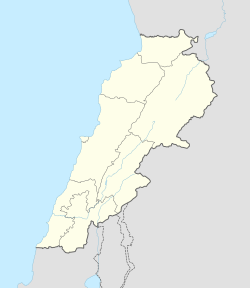Al-Aadaissah
Municipality in Nabatieh Governorate, Lebanon From Wikipedia, the free encyclopedia
Al-Aadaissah or Odaisseh (Arabic: العديسة / BGN: Aadaïssé / ISO 233: Al `Udaysah; also Adaisseh, Adessé, Odeissé, Odeissah and other spellings) is a municipality in south Lebanon.[1] It is located close to the Blue Line border with Israel, opposite the Israeli kibbutz of Misgav Am.[2] The majority of its population are Shia Muslims.[3]
Al-Aadaissah
العديسة | |
|---|---|
Municipality | |
 Al-Aadaissah | |
| Coordinates: 33°15′15″N 35°32′33″E | |
| Grid position | 201/295 PAL |
| Country | Lebanon |
| Governorate | Nabatieh Governorate |
| District | Marjayoun District |
| Elevation | 700 m (2,300 ft) |
| Time zone | UTC+2 (EET) |
| • Summer (DST) | UTC+3 (EEST) |
| Dialing code | +961 |
| Website | https://odaisseh.com/ |
Etymology
According to E. H. Palmer, the name Odeithat et Tahta means "the lower ’Odeitha".[4]

History
Summarize
Perspective
Ottoman period
Just north of Al-Aadaissah is a place formerly called 'Odeitha el Foka. In 1875, Victor Guérin described it as "an elevated plateau crowned with the ruins of a small fort of rectangular form, measuring forty paces long by thirty broad. It is in rubble work, with an external casing of regular stones of small size, and is divided in the interior into several compartments."[5] In 1881, the PEF's Survey of Western Palestine (SWP) found here: "A ruined Saracenic building with one cistern."[6]
In 1881, SWP found at the village (which it called Odeitha et Tahtâ) "cisterns and several lintels."[6] It further described it as "A village, built of stone, containing about 250 Metawileh, situated in valley surrounded by arable land. A market is held here one day each week. Water supply from spring in village, spring near, and several cisterns."[7]
21st century
The village was the site of the 2010 Lebanon–Israeli border clash, when Israeli and Lebanese forces engaged in cross-border combat.
Hezbollah's participation in the Gaza war (2023-), backing Hamas and initiating attacks on Israel, escalated the border zone into an active war zone characterized by frequent cross-border attacks. As a result, almost all of the village's residents have left.[3]

On the 21-23 October, 2024, a number of buildings in Al-Aadaissah were demolished by the Israeli military, among them a cultural centre and the family home of Lubnan Baalbaki, the conductor of Lebanon's philharmonic orchestra. The centre was full of his father's, the artist Abdel-Hamid Baalbaki (ar), collection of fine art and pottery, in addition to 2,000 manuscripts and books.[8]
Al-Aadaissah had observation and various missile lunchers posts situated around the village and its countryside from which several attacks were carried out on the nearby, lower, Israeli civilian settlements.[9]
According to Israeli reports, Odaisseh was supposed to be the jump-off point for Hezbollah's conquest of Misgav Am by a company of the Redwan Force. In just one raid, the IDF found six boxes full of rockets, anti-tank guided missiles, explosives, and RPGs inside residential buildings.[10]
Demographics
In 2014 Muslims made up 99.28% of registered voters in Al-Aadaissah. 97.12% of the voters were Shiite Muslims.[11]
Notable people
- Hussein Amine (born 1985), Lebanese footballer[12]
- Hussein Monzer (born 1997), Lebanese footballer[13]
References
Bibliography
External links
Wikiwand - on
Seamless Wikipedia browsing. On steroids.

